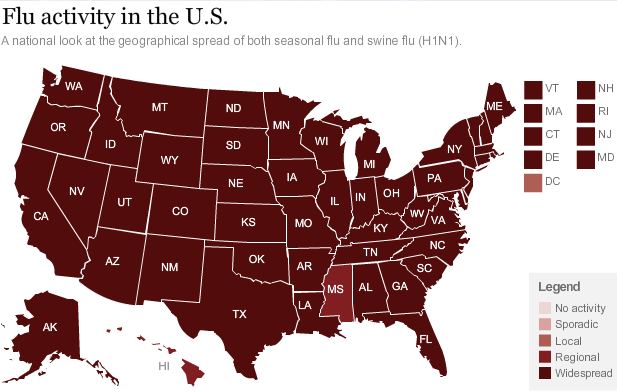
Source: CDC
Key Flu Indicators
November 6, 2009, 11:00 AM
Each week CDC analyzes information about influenza disease activity in the United States and publishes findings of key flu indicators in a report called FluView.* During the week of October 25-31, 2009, a review of the key indictors found that influenza activity remained high in the United States. Below is a summary of the most recent key indicators:
- Visits to doctors for influenza-like illness (ILI) nationally decreased very slightly this week over last week after four consecutive weeks of sharp increases. While ILI declined slightly, visits to doctors for influenza-like illness remain at much higher levels than what is expected for this time of the year and parts of the country continue to see sharp increases in activity. It’s possible that nationwide ILI could rise again. ILI continues to be higher than what is seen during the peak of most regular flu seasons.
- Total influenza hospitalization rates for laboratory-confirmed flu are climbing and are higher than expected for this time of year. Hospitalization rates continue to be highest is younger populations with the highest hospitalization rate reported in children 0-4 years old.
- The proportion of deaths attributed to pneumonia and influenza (P&I) based on the 122 Cities Report continues to increase and has been higher for five week now than what is expected at this time of year. In addition, 18 flu-related pediatric deaths were reported this week; 15 of these deaths were confirmed 2009 H1N1, and three were influenza A viruses, but were not subtyped. Since April 2009, CDC has received reports of 129 laboratory-confirmed pediatric 2009 H1N1 deaths and another 15 pediatric deaths that were laboratory confirmed as influenza, but where the flu virus subtype was not determined.
- Forty-eight states are reporting widespread influenza activity at this time; a decline of one state over last week. They are: Alabama, Alaska, Arizona, Arkansas, California, Colorado, Connecticut, Delaware, Florida, Georgia, Idaho, Illinois, Indiana, Iowa, Kansas, Kentucky, Louisiana, Maine, Maryland, Massachusetts, Michigan, Minnesota, Mississippi, Missouri, Montana, Nebraska, Nevada, New Hampshire, New Jersey, New York, North Carolina, North Dakota, Ohio, Oklahoma, Oregon, Pennsylvania, Rhode Island, South Carolina, South Dakota, Tennessee, Texas, Utah, Vermont, Virginia, Washington, West Virginia, Wisconsin, and Wyoming. This many reports of widespread activity at this time of year are unprecedented during seasonal flu.
- Almost all of the influenza viruses identified so far continue to be 2009 H1N1 influenza A viruses. These viruses remain similar to the virus chosen for the 2009 H1N1 vaccine, and remain susceptible to the antiviral drugs oseltamivir and zanamivir with rare exception
*All data are preliminary and may change as more reports are received.

